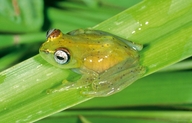|
Description
A small, green treefrog, males 21-26 mm; females unknown. Bright green with scattered brown spots, sometimes with a few large yellow spots on the dorsum. Upper eyelids yellow with brown. A moderately wide yellow line, bordered with brown spots, runs from the tip of the snout over the nostrils to the anterior corner of the eye. Venter pale green. Skin smooth. Iris silvery grey with brown reticulations. Nostrils slighly nearer to eye than to tip of snout. Tympanum rather indistinct, about 1/3 of eye diameter. Ratio of hand length/body length is 0.3-0.36. Tibiotarsal articulation reaches beyond tip of snout.
Webbing of the hand 1(1), 2i/e(1), 3i(2), 3e(1), 4(1-1.5); webbing of the foot 1(0), 2i/e(0), 3i(1), 3e(0-0.5), 4i/e(1), 5(0).
Males with small unpigmented nuptial pads and a single subgular, moderately
distensible vocal sac.
Similar species: In contrast to the other three species of the B. rappiodes-group, B. mandraka has no blue ring on the outer iris area. In B. ankaratra the tibiotarsal articulation does not reach beyond tip of snout. Distribution and Habitat
Country distribution from AmphibiaWeb's database: Madagascar
Mandraka. It occurs at 1,200m asl in secondary vegetation at the edge of streams near degraded rainforest (Vallan et al. 2008).
Life History, Abundance, Activity, and Special Behaviors
Calling males sit on shrubbery alongside rapids, about 2 m high, on
rainy nights. Adults and tadpoles are often associated with those of B. erythrodactylus.
Calls: Single short melodious whistling and clicking notes, emitted after irregular intervals. Call (from the terra typica): Three loud melodious clicks, followed by a very soft click. Call duration is 750 ms, frequency ranges from 2 to 5 kHz, with a dominant frequency of about 3.5 kHz.
Eggs and tadpoles (from the terra typica): Tadpoles live in rapids. They are
brown on the back; the belly is black in stage 25 and silvery grey in later
stages. On the caudal musculature, there are large, well defined dark brown
patterns with creamish background. The caudal fin is transparent, with a few
dark brown markings. Total length in stage 25: 26-35 mm; in stages 40-42: 37-40
mm. The mouth is broad and directed ventrally. At midlength of the tail, the
caudal musculature represents about 1/2 of the total tail height. Tooth formula
is 5/2+2//3. Metamorphosing juveniles measure about 13 mm from snout to vent.
Their colour is green, with brown pigmentation on the eyelids and along the
nostrils, and white spots on the back. Their hindlimbs are relatively shorter
than in adults.
Breeding takes place in streams (Vallan et al. 2008).
Trends and Threats
Data Deficient: continuing doubts as to its taxonomic status, extent of occurrence, status and ecological requirements. It is not known from any protected areas (Vallan et al. 2008). Possible reasons for amphibian decline General habitat alteration and loss
Habitat modification from deforestation, or logging related activities
Intensified agriculture or grazing
Urbanization
Habitat fragmentation
Comments
Taken with permission from Glaw and Vences (2007).
References
Glaw, F., and Vences, M. (2007). Field Guide to the Amphibians and Reptiles of Madagascar. Third Edition. Vences and Glaw Verlag, Köln.
Vallan, D., Glaw, F., and Vences, M. (2008). Boophis mandraka. In: IUCN 2008. 2008 IUCN Red List of Threatened Species. www.iucnredlist.org. Downloaded on 14 April 2009.
Originally submitted by: Miguel Vences and Frank Glaw (first posted 2000-10-24)
Edited by: Henry Zhu (2009-05-05)Species Account Citation: AmphibiaWeb 2009 Boophis mandraka <https://amphibiaweb.org/species/4350> University of California, Berkeley, CA, USA. Accessed May 29, 2025.
Feedback or comments about this page.
Citation: AmphibiaWeb. 2025. <https://amphibiaweb.org> University of California, Berkeley, CA, USA. Accessed 29 May 2025.
AmphibiaWeb's policy on data use.
| 